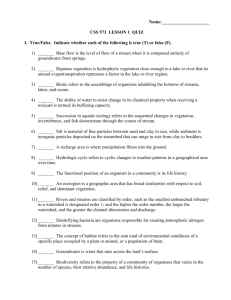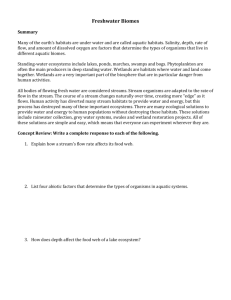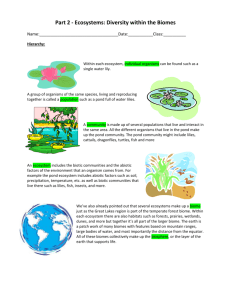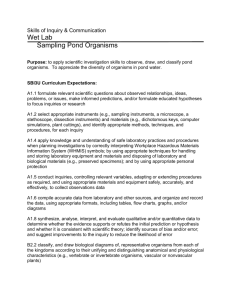fresh-water ecosystem - FacStaff Home Page for CBU
advertisement
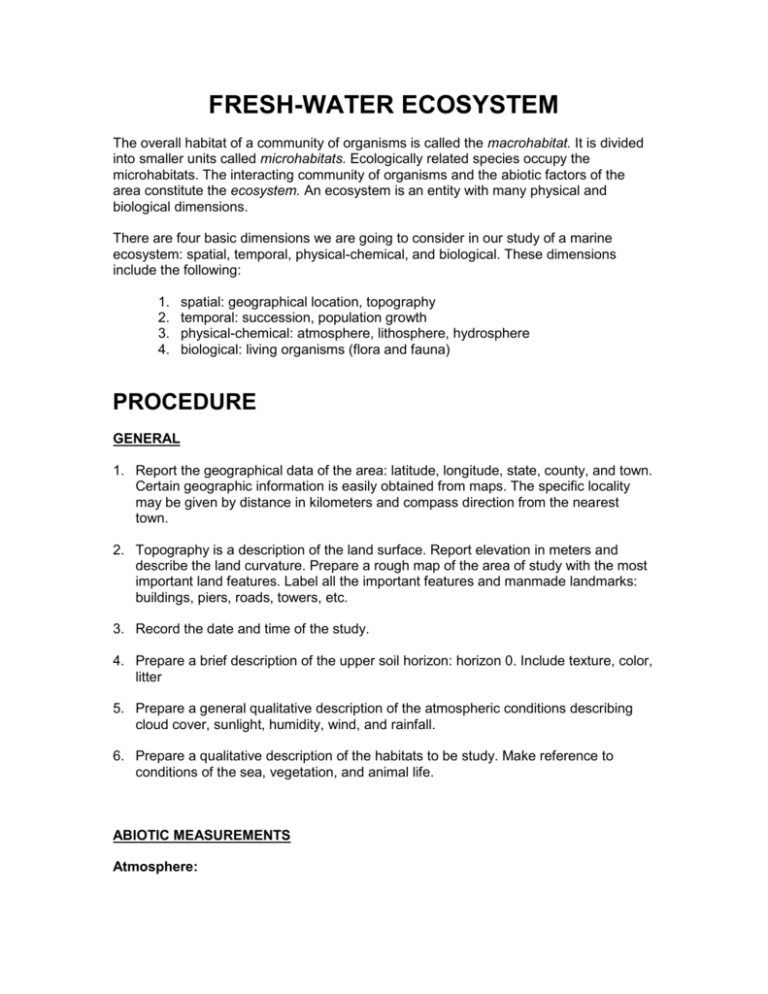
FRESH-WATER ECOSYSTEM The overall habitat of a community of organisms is called the macrohabitat. It is divided into smaller units called microhabitats. Ecologically related species occupy the microhabitats. The interacting community of organisms and the abiotic factors of the area constitute the ecosystem. An ecosystem is an entity with many physical and biological dimensions. There are four basic dimensions we are going to consider in our study of a marine ecosystem: spatial, temporal, physical-chemical, and biological. These dimensions include the following: 1. 2. 3. 4. spatial: geographical location, topography temporal: succession, population growth physical-chemical: atmosphere, lithosphere, hydrosphere biological: living organisms (flora and fauna) PROCEDURE GENERAL 1. Report the geographical data of the area: latitude, longitude, state, county, and town. Certain geographic information is easily obtained from maps. The specific locality may be given by distance in kilometers and compass direction from the nearest town. 2. Topography is a description of the land surface. Report elevation in meters and describe the land curvature. Prepare a rough map of the area of study with the most important land features. Label all the important features and manmade landmarks: buildings, piers, roads, towers, etc. 3. Record the date and time of the study. 4. Prepare a brief description of the upper soil horizon: horizon 0. Include texture, color, litter 5. Prepare a general qualitative description of the atmospheric conditions describing cloud cover, sunlight, humidity, wind, and rainfall. 6. Prepare a qualitative description of the habitats to be study. Make reference to conditions of the sea, vegetation, and animal life. ABIOTIC MEASUREMENTS Atmosphere: Make the following measurements every four hours between 8 AM and 8 PM: Temperature using a Celsius thermometer Relative humidity using a sling psychrometer Wind velocity using an anemometer Wind direction using a compass Light intensity using a photometer Hydrosphere: 1. You will study the physical and chemical characteristics of the water of a lake, pond or stream. Take a water sample from the selected area. Make sure your water samples are labeled with name of pond/stream, location, and date. 2. Analyze the chemical characteristics of the water samples in the laboratory following the standard procedure used in the past. 3. Measure the temperature and the oxygen content of the water using the oxygentemperature meter. 4. Record the turbidity of the water in the areas of study. 5. Measure the speed of the current. Measure 5 meters of the stream; drop a PingPong ball at the starting point upstream and time the number of minutes that it took the ball to pass the downstream mark. Give the speed in meters/sec. or min. Community of organisms: 1. The populations of species found living and interacting together in a given area constitute the community. This is the living component of the ecosystem. 2. Record the name and number of any vertebrate observed on the pond or stream, e. g. ducks, herons, muskrats, fish, etc. 3. Plankton are free floating and swimming aquatic organisms found in the upper layers of bodies of water. They are grouped into zooplankton and phytoplankton. Collect samples of plankton. Label the samples. Plankton organisms will be studied in the laboratory. 4. Describe the physiognomy of the surrounding vegetation. Find the name of the plants or give them a code name. Collect voucher specimens for later identification in the lab. Make sure you permission of the owner of the land before you collect any specimens for the lab. You may use the names of higher taxa like Gramineae for grasses or Gymnosperms for pines. The description of the vegetation should include comments on their spatial arrangement (even, random, and aggregate). Describe the stratification of the surrounding vegetation. Relate any changes in physiognomy to habitat factors, e.g. changes in topography, location in reference to the sea and exposure to salt spray, location in reference to the slope of the land surface, reproductive stage. 5. Describe and collect any submerged vegetation. 6. Describe and collect any emergent vegetation along the shoreline. 7. Collect invertebrates found in the mud and sand along the shore. Use the wooden frame sieves to collect the specimens. Find their phylum and name, or give them a code name. 8. Record any unusual features observed during the trip. The Ecotone The horizontal pattern, if any, should be recorded as a feature of the community structure. The ecotone is the edge effect or transition area between two communities. Can you observe a community change as you walk away from the edge of the pond or stream? The community of organisms may be distributed along an environmental gradient, resulting in a local gradation in species distribution called zonation. Prepare a sequential description (zonation patterns) of the vegetation around the stream, lake or pond as you move away from the edge of the pond or stream to higher ground and correlate them to topography or any other observable gradient. Include in your description any animals observed in your study area. Do not disregard the invertebrates. THE REPORT TITLE PAGE 1. 2. 3. 4. The title should be short and reflect the content of the paper Name of team members. Course name and number. Date due. INTRODUCTION It should explain what the objectives of the study are, and why it is a worthwhile effort. It should also provide the reader sufficient background to understand the report. What are you going to do? PROCEDURE Also called Materials and Methods, it should refer to... Where was the study done? This is important since the study requires fieldwork and data gathering in a location different from the laboratory, e.g., plants grown in the green house, animals trapped in the garden. When was the study done? Describe if the study was done over several days or hours of observation; how often were the reading made. Include the time of the year or the season. How was the study done? Methods used to collect animals and plants in the different areas of study and gather abiotic data. List special pieces of equipment and how they were used. The use of standard equipment like the light microscope does need to be described. Include unusual chemicals. Do not be overwhelming with unnecessary details. RESULTS This section should summarize the data and observations obtained in the study, but it should not discuss the implications nor draw conclusions. The presentation should start with the most general material and proceed to the more specific. The data should be organized into tables, graphs, etc. Extensive raw data should not be included. If the author wants to include it, then it should be placed in an appendix. Do not present tabular material in a text format. Do not repeat the presentation of the data as a table and as a figure. Be complete. In the case of lab experiments that have several sections, and data is gathered in each sections, the data and observations should be presented in a logical manner. Avoid mixing the data. Make sure all the observations and data has been reported. Figures and tables should be self-explanatory. Graphs should be labeled as well as tables and data sheets. Label the columns of a table; label the axes of a graph, point at the DISCUSSION Interpret the data in relation to the objectives of the paper or hypothesis. Compare the data and observations to that of others; relate the interpretation to existing theory and knowledge. Identify sources of error and basic inadequacies of techniques. Speculation is appropriate but it should be so identified. Suggest improvement in techniques, further areas of investigation, different experimental design. Reach conclusions about the objectives or hypothesis. Avoid a restatement of the results at a different level of generality. This section should be strongly interpretative. LITERATURE CITED There are several formats. List only the articles and books cited. This is not a bibliography that lists all works consulted but not necessarily cited. The listing should be alphabetical order by the last names of the authors. When citing references in the text, do not use footnotes; instead use the author's last name and the year of publication in parenthesis, e.g. (Jones, 1987). When citing papers that have several authors, list only the first one with the et al., from the Latin et alia (and others), as a substitute for the other authors, e.g. (Jones et al., 1987). If the author or authors are mentioned as part of the text, the citation should follow this format: "Jones et al. (1987) observed that....." You can find additional examples of cited articles, chapters of books, books, etc. in the Literature cited pages of scientific journal. Examples Articles: Baker, J.G. 1880. On a collection of ferns made by Dr. Beccari in western Sumatra. J. Bot. Brit. For. 18:209-217. Ching, R.C. 1931a. The studies of Chinese ferns, VII. A revision of the genus Tectaria from China and Sikkim-Himalaya. Sinensia 2:9-36. _____. 1931b. The studies of Chinese ferns, IV. Polypodium ellipticum Thunberg and species confounded with it. Bull. Fan Mem. Inst. Biol. Bot. 2:15-28, Pl. 1-8. Nayar, B.K., N. Bajpai, and F. Raza. 1966. Morphological studies on some species of Blechnum, Doodia, Woodwardia and Stenochlaena: I. the gametophytes and the juvenile sporophytes. J. Linn. Soc. Bot. 59:405423. Books: Copeland, E.B. 1947. Genera Filicum. Waltham, Mass.: Chronica Botanica. Bold, H.D.,C.J. Alexopoulos, and T. Delevoryas. 1987. Morphology of plants and fungi. Edition 5. Harper and Row: New York. Chapter of book. Christensen, C. 1938. Filicinae. In F. Verdoorn (Ed.) Manual of Pteridology. The Hague: Martinus Nijhooff. SELECTING THE STUDY SITE and COLLECTING. It should be a natural lake or stream. Man-made lakes or canals are not acceptable. You must collect samples of plants and animals, bring the them to the lab and classify them. At least the phylum should be determined for invertebrates. Grasses and herbs can be classified at least to the family level, and trees to the genus level.




